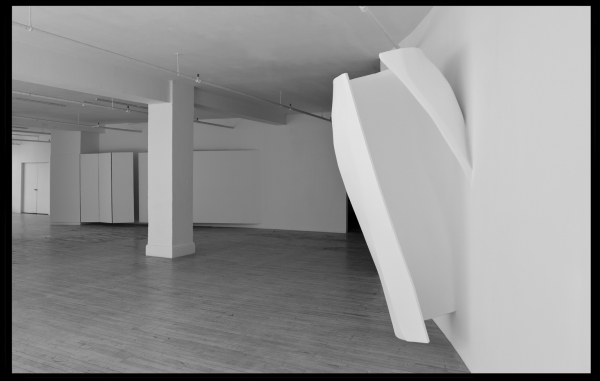Trouver sa place
- Francine LALONDE
When entering the large gallery at Circa, one sees three varying structures of relatively substantial size and curious shape. If one is familiar with Francine Lalonde’s work, one clearly has the feeling of being in well-known territory. Her work continues to be concerned with architectural issues but instead of sculptural elements spreading out into the space, the forms now are located next to the gallery walls, giving the impression of leaning against them.. Nevertheless, this new work marks a move away from the exploration of space that she has carried out up until now.
What does this new way of occupying space relate to? Clearly the artist is not trying to create critical commentary about the exhibition space as a white box, cutting the work off from the outside world, this would only be a reworking of modernism and formalism. Rather, she wants to suggest that the structures maintain a strong physical relationship to the surroundings. But here as well, one must not be misled. This is not strictly speaking a site-specific work, seeing that it does not try to emphasize the particularities of the place or to physically transform it, any more than it is an attempt to renew formalism, even if one readily recognizes the pleasure of playing with direct sensory and physical perceptions. What is it about then? To understand this new project, one must be aware of two key elements.
For a start, one must be attentive to the work as a whole, an indispensable condition to grasp the significant role given to light in this presentation. Playing with a combination of artificial light and natural light from the windows, the artist accentuates, for the visitor’s eyes, slight perceptual changes caused by this lighting device. Far from giving us a distancing experience of the space, the work tries to make us aware of a sensation that is usually not mentioned. Then, one must explore the sculptural elements themselves. Unlike the work that the artist presented in the small gallery a few years ago, these forms no longer protrude from the walls but seem to crack away from them to produce interstice into which the visitor is invited to enter. In one case, the work incites the viewer to bend over and slip underneath or to surreptitiously edge in behind it. In another piece, the space inside the structure is left unoccupied so that one can enter into it. And finally, in the third work, the piece is pliable and retractable, looking like a cocoon but also an observation post.
Thus, to take into account the play of light sources with the physical experience of the sculptural pieces, the visitor must move throughout the gallery space. This directed movement encourages a complex reading of place, a kind of visual moving back and forth between the original space and what has been added. This reading, which attempts to recreate a place for individual subjectivity, also reintroduces the world of affects into the work’s reception through the transition from motion to emotion, which is just one aspect of this sculptural project’s success.
Pierre Rannou
Translated by Janet Logan
Francine Lalonde studied fine art at Concordia University and at UQAM and translation at Université de Montréal. Her work has been presented in solo exhibitions in various artist-run centres and galleries in Canada such as Articule, La Centrale, Skol and Circa in Montréal, Eyelevelgallery in Halifax and Grunt in Vancouver, and also at Hangar in Barcelona, Spain where she sejourned in 2004 as part of a Quebec-Catalonia exchange. She participates regularly in government public art programs to integrate art into architecture in Montreal and regionally, and since 2000, she has been teaching in the fine arts department at Collège Édouard-Montpetit. She lives and works in Montreal.
Francine Lalonde would like to thank Alain Bourdeau and Justine Chouinard for their technical support, Louis Fortier for his always judicious comments, Peter King and Atelier Clark, Jacques Ladouceur for accurately making the metal structures from the scale model, Pierre Rannou for his understanding of the work, Martin Schop for his marvellous frames and also the Canada Council for the Arts and the Conseil des arts et lettres du Québec for their financial support.
Pierre Rannou is an art historian. He was co-curator with Bernard Lamarche for La photographie hantée par la photographie spirite an exhibition presented at Musée régional de Rimouski in 2008; the catalogue came out in 2009. He has also published Incipit. Stratégies autobiographiques dans Rue Ordener, rue Labat de Sarah Kofman (2005) and L’impossible cinéma post-moderne (Le temps vole, 1995) and has contributed texts to L’Atelier en déplacement, Bruno Santerre (Centre Sagamie, 2009) and Sur les traces de Diane Robertson (Paje Éditeur, 1994). Over the past few years, he has written for various magazines as a critic and essayist (Esse arts+opinions, Inter art actuel, ETC., Art le Sabord, Frontières). He teaches at Collège Édouard-Montpetit.





